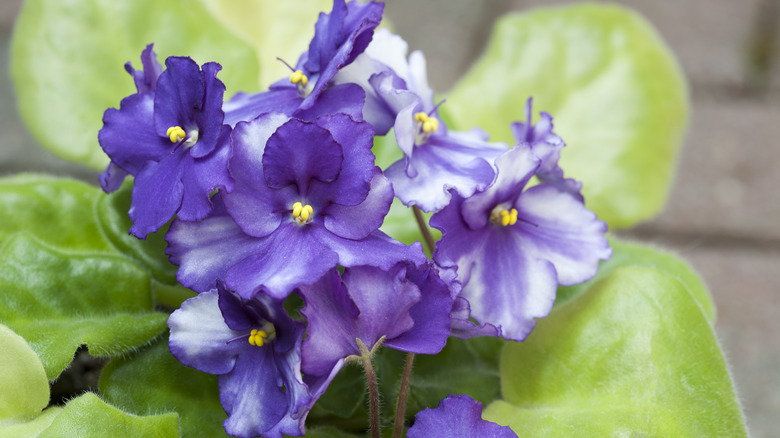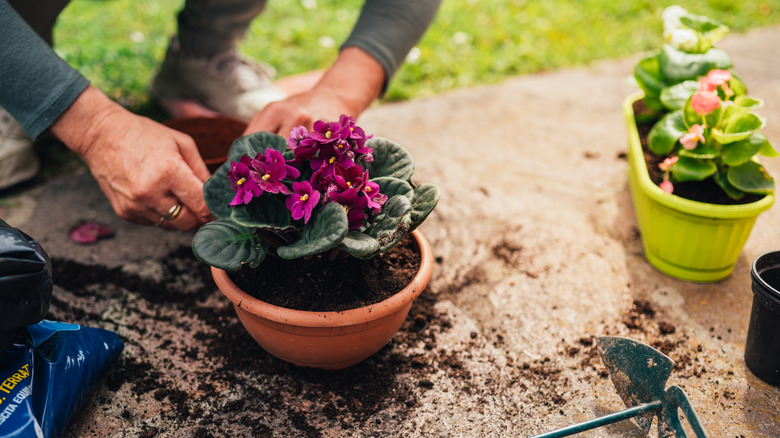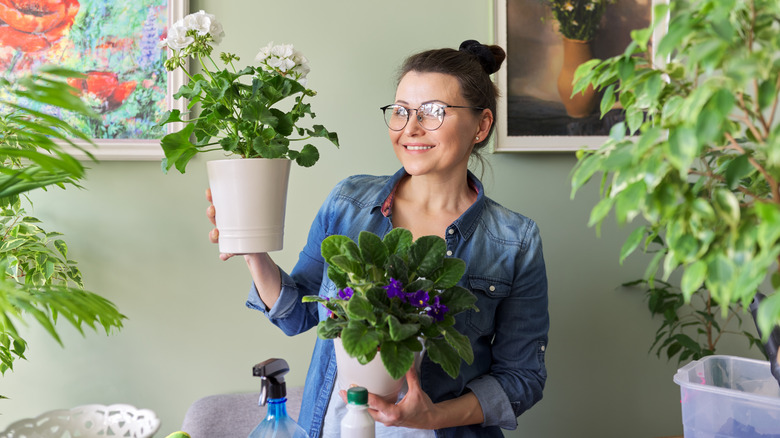What To Do If The Leaves On Your African Violet Are Curling
Did you know that African violets aren't really violets? They belong to the Saintpaulia family. Their vibrant leaves are part of their appeal and, every so often, these leaves curl. In some circumstances, this can be normal. However, this could mean that there's an issue that needs addressing. For example, you may need to adjust the temperature in your home, fix the humidity levels, or look for spider mites. If you encounter the latter and notice an infestation, you can remove them with 70% isopropyl alcohol. You may also consider the amount of sunlight your African violet receives, as these issues (and more) can all contribute to curled leaves.
Your African violet requires between 12 and 16 hours of daily indirect sunlight, but you may need to make adjustments based on the way its leaves are curling. If you notice its leaves curl upward, you should increase how much sunlight the plant receives. However, when its leaves curl downward, it's likely receiving too much sunlight. No matter what the reason is behind the sudden curling of your prized plant's leaves, there's usually a way to correct the issue. Unfortunately, though, certain circumstances might involve discarding your African violet, especially if it does indeed have spider mites. You don't want to risk an infestation affecting other nearby plants, but spraying the plant with 70% isopropyl alcohol every other day may rectify the issue. Here are some other ways you can address curled leaves on your African violet.
Water your African violets appropriately
If you're watering your African violets every day, chances are you're causing their leaves to curl. Their roots rely on air and too much water makes the soil soggy. From there, its roots can begin to rot. This is why you should only water your African violets once a week. However, you need to check your plant's leaves before adding more water, as you don't want it overly saturated. If they're crisp and fresh, it has enough water. If they're starting to wilt, it's time to hydrate the soil.
When you notice its leaves curling, you should bottom water your plant. All you need to do is fill a tray with 1 inch of water, put your African violet plant in it, let it sit for 20 minutes, and then remove it. This ensures its soil has enough time to drink up all the water it needs for that week, which means you won't overwater it. Curls aren't the only issue its leaves encounter, however. A few drops of water on your African violet can leave marks on its leaves. This is another reason why bottom watering is ideal for this type of house plant.
Keep a comfortable indoor temperature
Your African violets thrive between 65 degrees Fahrenheit and 80 degrees Fahrenheit. As temperatures drop, you'll see their leaves curl as they try to retain heat. Anytime you see their leaves curled and fragile-looking, they're most likely responding to the drop in temperature. African violets also do best when you control the humidity, especially in the winter or whenever it gets particularly dry out. You can place them near a humidifier to help fix the issue, as African violets do best at 80% humidity. If this seems like too much work, however, you can put them on a tray filled with pebbles and water — the evaporating water will provide the same type of effect as a humidifier.
Extra fuzz on its curled, delicate leaves is another sign that your African violet is cold. You don't have to build a greenhouse to correct this problem — just look for somewhere in your home that offers more warmth. Check for drafts, especially if your African violet is near windows or under vents. There are tons of easy ways to keep your African violet leaves from curling as long as you understand the root of the issue.


